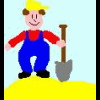
this project / page is under construction
Table of Contents
Introduction
24-03-2022
Playing back a CD is actually quite simple, all you need is a CD player that you connect to your preamplifier. With records, the situation is much more complicated, especially if you have high expectations of the playback quality.
The following components are needed to play back a record:
- Turntable
- Tonearm
- Cartridge
- Phono Preamplifier
However, this is not enough. A turntable / tonearm / cartridge combination must be precisely aligned mechanically.
- An exact horizontal alignment of the turntable
- Distance measurement platter center – tonearm center of rotation
- Tracking Force
- Overhang or tangential zero crossings
- VTA adjustment / measurement for exact horizontal alignment of the tone arm
- Antiskating
- Azimuth
Some of the settings must be performed once, for the others it makes sense to repeat them after you have performed the complete settings. By this I mean, for example, the overhang, which is (slightly) changed by a setting of the VTA.
In addition, you should keep the records as clean as possible. If you want to do this ambitiously, you can not avoid the purchase of a record washing machine.
Turntable
08-07-2021
The task of the turntable is to make the record rotate at a constant speed of 33.3rpm or 45rpm – beyond that, there are other speeds, but these two are the most important. In addition, the turntable is designed to keep mechanical vibrations away from the record. It usually also serves as a carrier for the tonearm or tonearms.
This task can be divided among the four essential components of a turntable:
- the platter with its bearing
- Fixture(s) for the tonearm(s)
- the motor incl. coupling to the platter
- the base with the mechanical isolation
Over the decades, there have been so many fantastic and interesting solutions. It is not possible to go into them individually at this point, as they would fill books. How my friend Jürgen and I approached this topic can be read here. With this masterpiece from his hand I received a/my dream turntable. It will also remain a unique piece, which of course has a very special charm.
Tonearm
08-07-2021
The large number of tonearms on the market are rotary tonearms with an effective length between 9″ and 12″. There are also longer lengths, but they are rather a rare species. The majority of tonearms on the market have a length between 9″ and 10″.
In addition to the rotary tonearms, there are also tangential arms. They have the advantage that they track the record exactly as they have been cut. But there are not really many manufacturers who sell such arms and such tonearms are also not a cheap purchase.
My preference is for the 12″ rotary arms, because as they say among sailors: “Length runs”. With the large diameter of my turntable, only arms with at least this length are possible. However, the platter is only so large because I prefer this length – I already had a 12″ tonearm before. A tangential tonearm that could be mounted on my turntable is not available on the market.
In my opinion, the best rotary tonearm on the market in terms of sound is the Danish Mørch DP-8. It’s not really a cheap arm, however, it’s downright throwaway when you consider the audiophile performance. However, adjusting this tonearm is very challenging and it is certainly not recommended for beginners. As another arm I use an English SME 312 with damping tray. Like actually all SME arms it is a successful construction with a very decent audiophile performance.
Cartridge
08-07-2021
The cartridge converts the musical information mechanically stored on the record into electrical signals. The vast majority of systems on the market use electromagnetic induction for this purpose.
An MM (Moving Magnent) system uses the needle to move a magnet, which induces a voltage corresponding to the movement in two fixed coils. With the MC system (Moving Coil) it is the other way around. Here, the needle moves two coils in a fixed magnetic field.
My preference is for the MC systems. They generate a very homogeneous magnetic field in which the small coils then move. Certainly most of the top transducers on the market work according to this principle. However, it is not easy to change the needle, as the coils are permanently mounted on it and wired to the rear connections. An MC system is therefore a wearing part. The output voltage of a MC system is also much lower than that of a MM system. You need an additional amplification of about 30dB.
By chance I got a van den Hul Colibri for a good price years ago. It was love at first sound. Today I own two of these exceptional cartridges. However, they are mercilessly analytical, which certainly does not please everyone. In addition, they react extraordinarily critically to the VTA setting (Vertical Tracking Angle), which is the reason for the mechanically very complex VTA adjustment on my turntable.
Phono Preamplifier
08-07-2021
The phono preamplifier has the task of amplifying the tiny signals coming from the cartridge. With a transducer according to the moving magnet principle it is about 40dB and with one according to the moving coil principle about 70dB at a frequency of 1kHz. The second essential task is to equalize the signal. The music signal on a record is not recorded linearly and the phono preamplifier must linearize the signal. For today’s records the so called RIAA curve (500C-13.7) is used, but for older recordings there are a lot of other curves.
One of the best phono preamp for the DIY community is certainly a replica of the Pass Labs XOno. How such a thing can look like can be seen here. I myself use a further development of it, which is not suitable for the replica for several reasons.